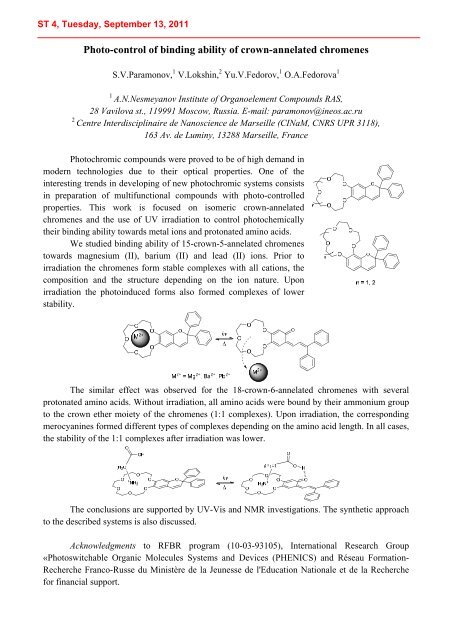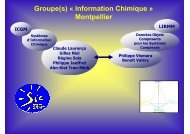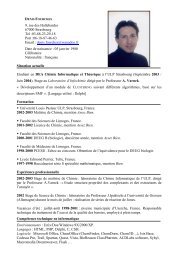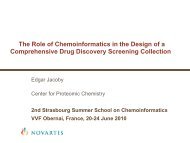International Summer School PROGRAM - Laboratoire d'Infochimie ...
International Summer School PROGRAM - Laboratoire d'Infochimie ...
International Summer School PROGRAM - Laboratoire d'Infochimie ...
Create successful ePaper yourself
Turn your PDF publications into a flip-book with our unique Google optimized e-Paper software.
Photo-control of binding ability of crown-annelated chromenes<br />
S.V.Paramonov, 1 V.Lokshin, 2 Yu.V.Fedorov, 1 O.A.Fedorova 1<br />
1<br />
A.N.Nesmeyanov Institute of Organoelement Compounds RAS,<br />
28 Vavilova st., 119991 Moscow, Russia. E-mail: paramonov@ineos.ac.ru<br />
2<br />
Centre Interdisciplinaire de Nanoscience de Marseille (CINaM, CNRS UPR 3118),<br />
163 Av. de Luminy, 13288 Marseille, France<br />
Photochromic compounds were proved to be of high demand in<br />
modern technologies due to their optical properties. One of the<br />
interesting trends in developing of new photochromic systems consists<br />
in preparation of multifunctional compounds with photo-controlled<br />
properties. This work is focused on isomeric crown-annelated<br />
chromenes and the use of UV irradiation to control photochemically<br />
their binding ability towards metal ions and protonated amino acids.<br />
We studied binding ability of 15-crown-5-annelated chromenes<br />
towards magnesium (II), barium (II) and lead (II) ions. Prior to<br />
irradiation the chromenes form stable complexes with all cations, the<br />
composition and the structure depending on the ion nature. Upon<br />
irradiation the photoinduced forms also formed complexes of lower<br />
stability.<br />
The similar effect was observed for the 18-crown-6-annelated chromenes with several<br />
protonated amino acids. Without irradiation, all amino acids were bound by their ammonium group<br />
to the crown ether moiety of the chromenes (1:1 complexes). Upon irradiation, the corresponding<br />
merocyanines formed different types of complexes depending on the amino acid length. In all cases,<br />
the stability of the 1:1 complexes after irradiation was lower.<br />
The conclusions are supported by UV-Vis and NMR investigations. The synthetic approach<br />
to the described systems is also discussed.<br />
Acknowledgments to RFBR program (10-03-93105), <strong>International</strong> Research Group<br />
«Photoswitchable Organic Molecules Systems and Devices (PHENICS) and Réseau Formation-<br />
Recherche Franco-Russe du Ministère de la Jeunesse de l'Education Nationale et de la Recherche<br />
for financial support.









